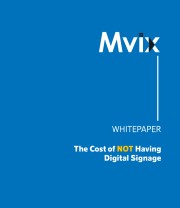
A new whitepaper by Mvix, a pioneer in affordable digital signage, explores the opportunity cost of not having digital signage, and why businesses skimping on this technology should be worried.
Sterling, VA, December 17, 2015 (Newswire.com) - The use of digital signage to achieve marketing and communications goals is delivering new plateaus of value in retail, food services, hospitality, corporate, healthcare, and education environments, among others. Despite this, there still are businesses that have not fully bought into the potential of digital signage. To them, the technology is simply an expensive way to replace printed ads.
The thought leadership paper explains why that is dangerous thinking, especially in today’s digitized world that has changed the way people consume information. Only less than 10 years ago, the digital world was a simpler place. People used desktops and laptops to get at their information. And the content they consumed was mostly text. Today, the digital ecosystem is increasingly fragmented, and new technologies have significantly changed not only the way people consume content, but they type of content too. People now prefer their graphics before their text, rather than the opposite.
This paper will shed some light on the efficiencies brought about by digital signage, and hopefully make a compelling case for leveraging digital signage to achieve marketing and communications goals.
A. Jay, Senior Director of Business Relations
The paper discusses how due to this shift -- and the client/guest/employee/student expectation of dynamic yet personalized information delivery – businesses need to rethink how they’re communicating with and marketing to their audience. Digital signage mimics people’s daily interaction with technology, so they’re more likely to pay attention to a digital display than a printed poster.
From the paper:
“Humans are great at ignoring things that they find uninteresting, especially in the medium of print. Hubspot reported on the failings of snail mail and print marketing: they estimated that up to 44% of direct mail is never opened. This is no fault of the business: it’s a simple physiological human response to the stimuli in the environment.
There’s so much information hitting our eyeballs, and to compensate, a brain mechanism called the reticular activating system kicks in and filters out all of the unwanted junk. But despite the efficiency of our brains, digital displays are harder to ignore. Motion catches the eye; it’s human nature. Viewers will be much more receptive to dynamic digital signage than print signage.
The smallest amount of exposure can improve brand visibility and sales; a concept that our brains instinctively fight when viewing print media.
Digital signage can act as the cornerstone of a business’s visual presence, offering a unique way of linking the “bricks” of physical facilities with the “clicks” of online and mobile.”
To demonstrate the losses that come along with not having digital signage, the paper examined some efficiencies brought about by the technology:
Speed and efficiency
“Silent” endorsement
Less waste
Mvix is emerging as a leader in affordable digital signage. They are revolutionizing the digital signage space by offering affordable solutions, including a subscription-free yet powerful cloud-based digital signage software. This keeps costs low and frees up dollars to be spent on a content strategy, network management, maintenance etc. These elements combined carry more weight than the technology, and have a huge impact on the success of a digital signage project.
“The digital signage space is nearing maturity, and we have seen widespread adoption across the 12 verticals that we cater to,” said A. Jay, the Mvix Sr. Director of Business Relations. “However, there are those still not fully convinced of the advantages of digital signage. This paper will shed some light on the efficiencies brought about by the technology, and hopefully make a compelling case for leveraging digital signage to achieve marketing and communications goals.”
This new thought leadership paper can be downloaded or read online at The Cost of Not Having Digital Signage.
Share:
